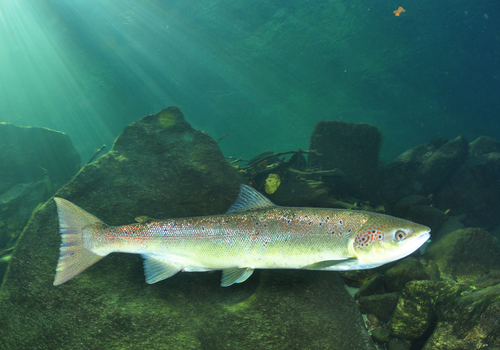
Atlantic Salmon
The Atlantic bluefin tuna (Thunnus thynnus) is a highly migratory, large pelagic fish renowned for its size, speed, and commercial value. It's a top predator in the marine ecosystem and plays a critical role in maintaining balance. This species is of significant cultural and economic importance.
3 13 years
Lifespan
71 - 76 cm
Length
Least Concern
Conservation Status
40 km/h
Swimming speed
Carnivorous, Insectivorous
Diet
Highly Migratory, Anadromous
Migration
Appearance Overview
The Atlantic bluefin tuna has a robust, streamlined body built for speed and endurance, with a metallic blue top and silvery-white underside.
Coloration
Dark metallic blue on top, silvery-white underside
Fins
Two dorsal fins, the first depressible into a groove; small finlets behind second dorsal and anal fins
Body Shape
Torpedo-shaped, streamlined for efficient swimming
Length
Up to 13 feet (4 meters)
Weight
Up to 2,000 lbs (907 kg)
Diet
Carnivorous, feeding on a variety of fish, squid, crustaceans, and eels.
Feeding Behavior
Highly active predator, using speed and agility to hunt; often feeds cooperatively, herding prey into tight groups.
Social Behavior
Forms large schools, particularly during migration; can be solitary or aggregate in groups based on size and age.
Commercial Relevance
Extremely high value, especially in sushi and sashimi markets; one of the most expensive fish in the world.
Conservation measures
Subject to strict international fishing quotas and management plans; marine protected areas and fishing gear restrictions are in place.
Status
Endangered (Varies by population segment; some stocks are recovering, while others remain depleted)
Threats
Overfishing, illegal fishing, bycatch in fishing gear, climate change affecting prey distribution.
Habitat Distribution
Depth Range
0-1,000 meters (typically in the upper layers of the ocean)
Geographic Range
Atlantic Ocean, Mediterranean Sea, and formerly in the Black Sea
Preferred Environment
Temperate and subtropical waters; both coastal and open ocean environments
Reproduction and Life Cycle
Breeding Habits
Spawns in warm waters, primarily in the Mediterranean Sea and the Gulf of Mexico; spawning occurs in specific areas with suitable conditions.
Development Stages
Eggs hatch into larvae, which develop rapidly in plankton-rich waters; juveniles grow quickly, eventually reaching immense sizes.
Fecundity
Females can produce up to 30 million eggs per spawning season, releasing them into the water for external fertilization.
Maturity Age
Matures at 4-8 years in the eastern Atlantic and Mediterranean, and around 9-12 years in the western Atlantic.
Faqs about Atlantic Salmon
How long do Atlantic bluefin tuna live?
Atlantic bluefin tuna can live up to 40 years, though this is rare due to fishing pressure.
How fast can bluefin tuna swim?
They are among the fastest fish in the ocean, capable of bursts of speed up to 43 mph (70 km/h).
Can you eat bluefin tuna?
Yes, but it's crucial to ensure it comes from a sustainable and legally sourced fishery due to their conservation status.
Are bluefin tuna warm-blooded?
They are warm-blooded, which allows them to maintain a higher body temperature than the surrounding water, aiding in muscle efficiency.
Why is bluefin tuna so expensive?
Bluefin tuna meat is highly prized for its flavor, texture, and high fat content, particularly in Japanese cuisine.
Why do bluefin tuna migrate?
They migrate to follow food sources and to reach spawning grounds, often traveling thousands of miles.
Where are bluefin tuna found?
They are found in the Atlantic Ocean, Mediterranean Sea, and formerly in the Black Sea.
What is the biggest threat to bluefin tuna?
The main threat is overfishing, which has severely depleted their populations over the past century.
Copyright @ Nature Style Limited. All Rights Reserved.
 English
English